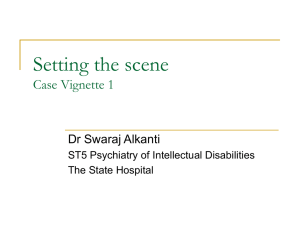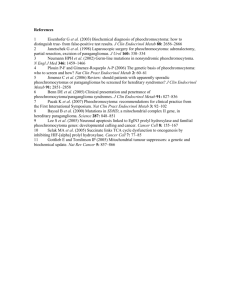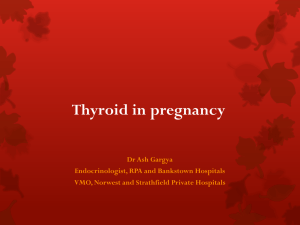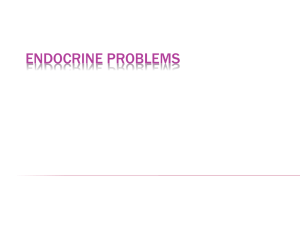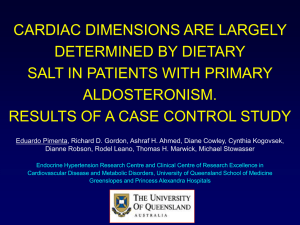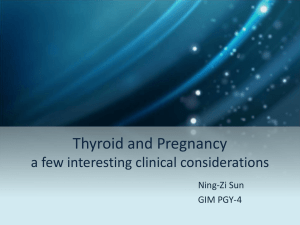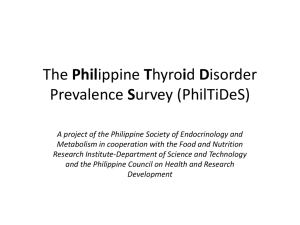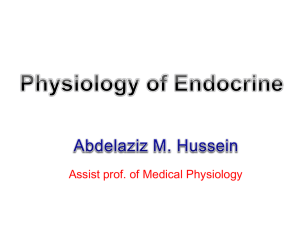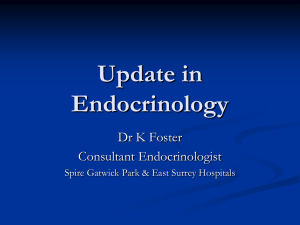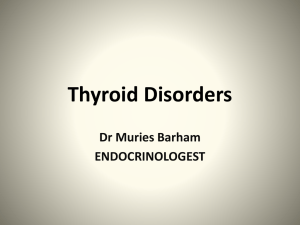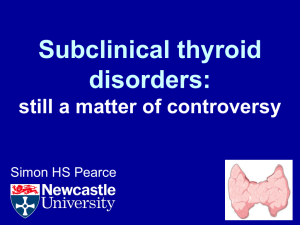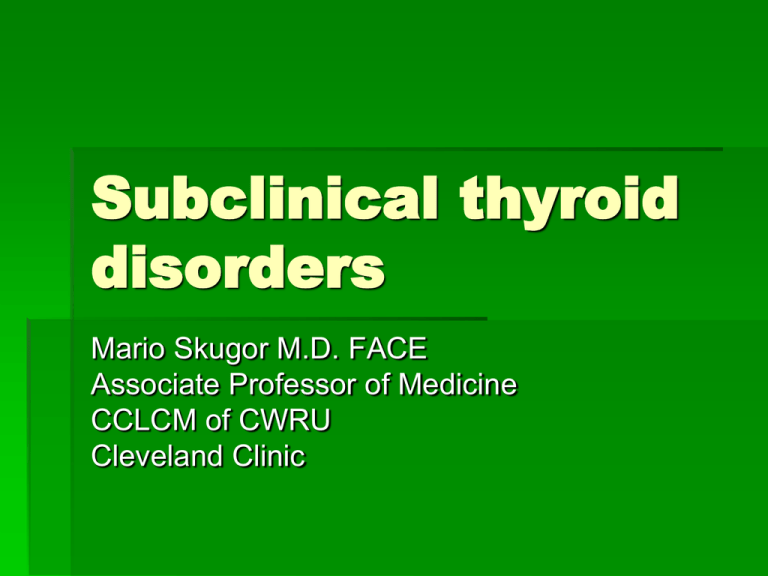
Subclinical thyroid
disorders
Mario Skugor M.D. FACE
Associate Professor of Medicine
CCLCM of CWRU
Cleveland Clinic
Definitions:
Individuals with elevation of TSH but
normal thyroid hormone levels have subclinical hypothyroidism*.
*Some authors consider patients with high-normal TSH
and abnormal response to TRH as having SCH.
Gharib H. et al. J Clin Endocrinol Metab 2005;90:581-585
Definitions:
Individuals with TSH lower than normal
but with normal thyroid hormone levels
have sub-clinical hyperthyroidism.
Gharib H. et al. J Clin Endocrinol Metab 2005;90:581-585
Normal TSH???
Normal TSH range
Most common assays in U.S.A.
0.4-5.5 uU/mL
0.27-4.2 uU/mL
Normal TSH???
Lower limit of the normal range is
somewhat variable but relatively well
established.
Normal TSH???
Upper level of normal range is
controversial.
Normal TSH???
0.4
5.5
NHANES III
N = 13,344
Healthy, antibody negative subjects
median
0.45
1.39
4.12
Normal TSH???
Consensus conference (ATA, AACE, Endo
Soc) accepted NHANES III derived normal
range.
National Academy of Clinical Biochemistry
proposed 0.4-2.5 uU/mL for normal range.
AACE proposed 0.3-3.0 uU/mL
Practical considerations
Results of lowering upper limit of normal
range from 5 to 2.5 uU/mL changes
prevalence of sub-clinical hypothyroidism:
4.6% to 20%
Fatourechi V. et al. JAMA 2003;290:3195-3196
Practical considerations
TSH varies with time.
Mildly abnormal TSH should be rechecked in
3-4 months to confirm persistent elevation.
Transient elevations are not uncommon.
Practical considerations
TSH elevations NOT associated with SC
hypothyroidism:
Recovery from non-thyroidal illness.
Adrenal insufficiency.
Treatment with metoclopramide and domperidone
TSH secreting adenomas
Thyroid hormone resistance
Assay variability
Late evening pulse in TSH secretion
Practical considerations
Decreased TSH also could be seen with
conditions that are not associated with
hyperthyroidism.
Practical considerations
Decreased TSH NOT associated with SC
hyperthyroidism:
Central hypothyroidism
Non-thyroidal Illness
Glucocorticoid and dopamine use
Recovery from hyperthyroidism
Early pregnancy
Practical considerations
Even TSH over 20 uU/mL can be
associated with normal TH levels.
Practical considerations
Attempts to identify individuals with mild
thyroid disorders based on search for
thyroid specific symptoms have not been
successful.
Sub-clinical hypothyroidism
Should be diagnosed in patients who do
NOT complain of symptoms associated
with hypothyroidism.
In patients who are screened for
presence of thyroid disorder because of
increased risk.
Elevated TSH normal TH
If patient complains of symptoms and
elevated TSH with normal TH is found,
than disorder cannot be considered to be
sub-clinical.
Mild hypothyroidism
In my opinion, after rechecking to confirm
TSH elevation, treatment should be
seriously considered in such patients.
TSH should be corrected to below 2.0
uU/mL and therapeutic effects assessed
after 2-3 months.
If benefit is derived treatment should be
continued.
Sub-clinical hypothyroidism
Individuals with TSH from upper limit of
normal to 10 uU/mL
With normal TH levels
With no symptoms that could be explained
by hypothyroidism
Have “Sub-clinical hypothyroidism”
Epidemiology
Whickham survey
Prevalence
Men
Women
Women >60 y
2.8%
7.5%
11.6%
Vanderpump MP. Et al. Clin endocrinol (Oxf) 1991;43:55-69
Epidemiology
NHANES III
Prevalence in 16,533 individuals
Patients with known thyroid disease were
excluded.
SCH found in 4.3%
Hollowell JG, et al. J Clin Endocrinol Metab 2002;87:489.
Epidemiology
Colorado Thyroid Disease Prevalence
Study
N – 25,862
Prevalence
Overall
18-24 y
Women >74
Men >74 y
9.5%
4.0%
22%
16%
Canaris GJ. Et al. Arch Intern Med 2000:160:526-534/
Epidemiology
Increased prevalence is reported in
patients with:
Diabetes mellitus type 1
Schmidt’s syndrome
Celiac disease
(1)
(2)
(3)
Due to presence of Hashimoto’s thyroiditis
1. Vondra K. et al. J Endocrinol Invest 2004: 27:728-732.
2. Betterie C. et al. Endocr rev 2002;23:327-364.
3. Sategna-Guidetti C. et al. Am J Gastroenterol 2001:96:751-757.
Etiology–SC hypothyroidism
Common causes
Iatrogenic
In patients with coexisting heart disease
In patients with malignant diseases
In patients with poor compliance
In patients taking medications inappropriately
Etiology–SC hypothyroidism
Common causes
Iatrogenic
Hashimoto’s thyroiditis
Most common cause
54% of SCH patients in U.S. are abs positive (1)
UK study found abs in 67% of women and 40%
of men with SCH (2)
1. Hamburger JI, et al. NEJM 1985;313:267.
2. Tonbridge WM. Et al. Br Med J 1974;3:89.
Etiology–SC hypothyroidism
Common causes
Iatrogenic
Hashimoto’s thyroiditis
Postpartum thyroiditis
Etiology–SC hypothyroidism
Common causes
Iatrogenic
Hashimoto’s thyroiditis
Postpartum thyroiditis
Medications
Amiodarone
Lithium
Interferon
Sunitinib
Sorafenib
Etiology–SC hypothyroidism
Common causes
Iatrogenic
Hashimoto’s thyroiditis
Postpartum thyroiditis
Medications
Partial thyroidectomy
Etiology–SC hypothyroidism
Common causes
Iatrogenic
Hashimoto’s thyroiditis
Postpartum thyroiditis
Medications
Partial thyroidectomy
Head and neck radiation
Etiology–SC hypothyroidism
Common causes
Iatrogenic
Hashimoto’s thyroiditis
Postpartum thyroiditis
Medications
Partial thyroidectomy
Head and neck radiation
RAI ablation of Graves’ disease
Clinical consequences
Progression to overt hypothyroidism
2-5% yearly
10% may eventually normalize
Higher initial TSH – higher the risk of
progression
Positive AMA-s – higher risk of progression
Huber G. et al. J Clin Endocrinol Metab 2002;87:3221-3226.
Diez JJ. et al. J Clin Endocrinol Metab 1991:72:209-213.
Clinical consequences
Development of hypothyroidism, 20 year
follow up – Whickham survey
27% if abs positive
33% if TSH higher than normal
55% if TSH higher and abs positive
4% if TSH was normal and abs negative
Vanderpump MP. Et al. Clin endocrinol (Oxf) 1991;43:55-69
Clinical consequences
Vanderpump MP. Et al. Clin endocrinol (Oxf) 1991;43:55-69
Clinical consequences
Risk of CV disease
Diastolic dysfunction
Diastolic hypertension
Increase in LDL-C
Increased hsCRP
Alteration in coagulation parameters
Endothelial dysfunction
Alber CP. et al. Am Heart J 1964
Diez JJ. et al. J Clin Endocrinol Metab 1991:72:209-213.
Clinical consequences
Risk of CV disease
Whickham survey showed no association
over 20 years with:
Coronary heart disease
Dyslipidemia
Mortality
Vanderpump MP, et al. Clin Endocrinol (Oxf) 1991:43:55-69.
Clinical consequences
Risk of CV disease
Rotterdam study showed increased
prevalence of atherosclerosis (odds ratio
1.7) and MI (odds ratio 2.3) in women with
SCH.
Hak AE, et al. Ann Intern Med 2000;132:270-278.
Clinical consequences
Risk of CV disease
Studies show mixed results but population
studied are different and number of patients
are usually small (total number of subjects is
high but patients with SCH are not many).
Example – 4331 subjects but 281 with SCH (1)
Pearce EN, et al. Endo Soc, Boston MA abstract 42-1.
Controversy
McDermott MT, Ridgway EC 2001
Subclinical hypothyroidism is mild thyroid
failure and should be treated. J Clin
Endocrinol Metab 86:4585–4590.
Chu JW, Crapo LM 2001 The treatment of
subclinical hypothyroidism is seldom
necessary. J Clin Endocrinol Metab 86:
4591–4599.
Clinical Consequences
Fertility
17% of Tg and AM antibodies positive had
spontaneous miscarriage, compared to 8.4%
of antibody negative women (1)
2.3% of 25,756 pregnant women had SCH,
and their risk for placental abruption and
preterm delivery was 2 times normal (2)
1. Stagnaro-Green A, et al. JAMA 1990;264:1422-1425.
2. Casey BM, et al.Obstet Gynecol 2005;105:239-245.
Clinical Consequences
Fertility
The 16 and 11 recurrent aborters with
positive TPO-abs were treated with T4 and
IV immunoglobulins respectively.
T4 treated patients had 81.2% delivery rate
and IV Immunoglobulin treated 54.5%.
Vaquero E, et al. Am J Reprod Immunol 2000;43:204-208
Clinical Consequences
Neuropsychiatric disorders
SCH patients with depression have poorer
response to antidepressant medications (1)
SCH patient have increased lifetime
prevalence of depression (2)
Women with SCH and goiter have increased
rate of anxiety and depressive features (3)
1. Joffe RT, Levitt AJ. Psychoneuroendocrinology 1992;17:215
2. Haggerty JJ, et al. Am J Psychiatry 1993:150:508.
3. Monzani F, et al. Clin Invest 1993;71:367.
Clinical Consequences
Mortality
CV health study (N = 3,233) showed NO
increase (1)
Meta-analysis showed increased risk in
those older than 65 (2)
Several studies showed increase in CV and
all-cause mortality (3-5)
1.
2.
3.
4.
5.
Cappola AR, et al. JAMA 2006;295:1033.
Razvi S, et al. J Clin Endocrinol Metab 2008;93:2998.
Imaizumi M, at al. J Clin Endocrinol Metab 2004:89:3365.
Iervasi G, et al. Arch Intern Med 2007;167:1526.
Walsh JP, et al. Arch Intern Med 2005;165:2467.
Our experience
We examined cohort of 6,408 patients at HIGH
RISK for cardiovascular disease.
Patients were enrolled in cardiovascular
disease prevention program of Cleveland
Clinic between January 16, 1995 and June 25,
2008.
Data about patients were entered in the
Preventive Cardiology Information System
(PreCIS) database.
McQuade C, et al. ATA meeting, Chicago IL, 2008 abstract 311.
Methods
Patients:
Secondary prevention ~ 50%
Primary prevention ~ 50%
Hypercholesterolemia
Strong family history of CVD
The CVD risk factors are aggressively
treated.
Methods (cont)
Five TSH intervals predefined:
<0.4 µU/ml (hyperthyroid)
0.4-3.0 µU/ml (normal)
3.0-6.0 µU/ml (mild SCH)
6.0-10.0 µU/ml ( moderate SCH)
>10.0 µU/ml (hypothyroid)
Methods (cont)
Number of patients:
<0.4 µU/ml
0.4-3.0 µU/ml
3.0-6.0 µU/ml
6.0-10.0 µU/ml
>10.0 µU/ml
No TSH available
168 patients
4,755 patients
1,214 patients
178 patients
79 patients
14 patients
Patients characteristics:
There was no difference between groups:
Framingham risk score
Diabetes mellitus
LDL
Lp(a)
Microalbuminuria
Body mass index
Diastolic blood pressure
Results
Adjustment was made for:
Age
Sex
Smoking
HDL
LDL
Systolic blood pressure
Diastolic blood pressure
Diabetes
Results
After adjusting for common risk factors
there were no increased risk for the
group of patients with TSH less than
0.4.
All cause mortality - adjusted
AllAllPatients
Patients (n = 6,394)
1.0
.9
TSH Category
p<0.001
P<0.001
0.4-3.0
.8
C um S urviv al
3.0-6.0
6.0-10.0
.7
>10.0
.6
Source: Arial 9pt, left-aligned with slide title
0
1
Time in Years
2
3
4
5
6
7
8
All cause mortality - adjusted
AllPatients
Patients (n = 6,394)
All
1.0
.9
TSH Category
P=0.021
0.4-3.0
.8
C um S urviv al
3.0-6.0
6.0-10.0
.7
>10.0
.6
Source: Arial 9pt, left-aligned
with
slide title2
0
1
Time in Years
3
4
5
6
7
8
Limitations
Thyroid status based only on elevated TSH
values as L-T4 and T3 values are not
consistently available
The PreCIS database consists of exclusively
preventive cardiology patients at the Cleveland
Clinic. The cohort is highly selected for
patients with or at risk for CHD. Results may
not be generalizable
Cause of death cannot be determined from the
SS death index.
Effect of treatment
Psychometric outcomes and hypothyroid
symptoms scores in double blind
randomized trials:
Improvement is seen consistently in those
with TSH >10 uU/mL.
Cooper DS, et al. Ann Intern Med 1984;101:18.
Nystrom E, et al. Clin Endocrinol 1988;29:63.
Jaeschke R, et al. J Gen Intern Med 1996;11:744.
Meier C, et al. J Clin Endocrinol Metab 2001;86:4860.
Effect of treatment
Cholesterol
T4 treatment decreases:
Total Cholesterol in those with initial level over
240 mmol/L (meta-analysis)
LDL – C
Apolipoprotein B-100
Danese MD, et al. J Clin Endocrinol Metab 2000;85:2993.
Mikhail GS, et al. Endocr Pract 2008;14:570.
Iqbal A, et al. J Intern Med 2006;260:53.
Effect of treatment
Cardiac function, blood pressure
Cardiac output increases (1)
Vascular resistance decreases (1)
Mean arterial pressure decreases (1)
Carotid intimal-media thickness decreases
(2)
Diastolic and systolic function improve (3)
1. Faber J, et al. Thyroid 2002;12:319.
2. Adress M, et al. Clin Endocrinol 2008.
3. Turhan S, et al. J CLin Endocrinol Metab. 2006;91:3490.
Bottom line:
I treat individuals with SCH if there are
associated clinical symptoms or positive
thyroid autoantibodies.
A 2-6 months later clinical and laboratory
response is assessed.
Decision to treat or not to treat further is
made in discussion with patient.
SC hyperthyroidism
Etiology
Iatrogenic
25% of patients taking T4 may have low TSH.
Some of these are intentional
Thyroid carcinoma
History of head and neck radiation
Presence of nodules and goiters
De Whalley P. Br J Gen Pract 1995;45:93.
SC hyperthyroidism
Etiology
Iatrogenic
Autonomous nodules (solitary and in MNG)
A 22% of patient with MNG found to have SC
hyperthyroidism (1)
In hyperthyroid patients over 55 years of age with
MNG 57% were sub-clinical (2)
Diaz JJ. Gerontology 2003;49:316
Rieu M, et al. Clin Endocrinol 1993;39:67
SC hyperthyroidism
Etiology
Iatrogenic
Autonomous nodules (solitary and in MNG)
Graves’ disease
About 6% of patients with Graves’ disease are
sub-clinical.
Diaz JJ. Gerontology 2003;49:316.
SC hyperthyroidism
Etiology
Iatrogenic
Autonomous nodules (solitary and in MNG)
Graves’ disease
Thyroiditis
Graves’ disease in remission
High hCG
SC hyperthyroidism
Epidemiology
Reports vary from 0.7% to 12.4%
NHANES III showed 0.7% (1)
Smokers two times higher prevalence.
Another study found 1.8% with TSH <0.1 uU/mL
in U.S. (2)
In England 6% had TSH <0.5 uU/mL (3)
1. Hollowell JG, et al. J Clin endocrinol Metab 2002;87:489
2. Sawin CT, et al. Arch Intern Med 1991;151:165.
3. Parle JV, et al. Clin Endocrinol (Oxf) 1991;34:77.
SC hyperthyroidism
Natural course
40-60% normalize (1-3)
About 4% progresses to overt
hyperthyroidism (4,5)
1.
2.
3.
4.
5.
Eggersten R, et al. BMJ 1988;297:1586
Parle JV, et al. Clin Endocrinol (Oxf) 1991;34:77.
Meyerovitch J et al. Arch Intern Med 2007;167:1533.
Sawin Ct, et al. Arch Intern Med 1991;151:165
Sandrock D, et al. Acta endocrinol (Copenh) 1993;128:51
Clinical consequences
Bone metabolism
No good data on fracture rates.
A meta-analysis found decreased BMD, but
only in postmenopausal women (1).
In those taking T4 low BMD was found only
if dose was higher than 1.6 mcg/kg/d (2).
Markers of bone turnover have been
reported to be increased (3)
Faber J, Galloe AM. Eur J Endocrinol 1994;130:350
Schneider DL, et al. JAMA 1994;271:1245
Loviselli A, etr al. Thyroid 1997;7:561
Clinical consequences
CV effects
Atrial fibrillation
Prospective study- 2,000 adults over 60 followed
for 10 years
TSH <0.1 uU/mL
TSH 0.1-0.4 uU/mL
TSH >0.4 uU/mL
- 28% cumulative incidence
- 16% cumulative incidence
- 11% cumulative incidence
Cappola AR, et al. JAMA 2006;295:1033.
Clinical consequences
CV effects
Atrial fibrillation
A cross-sectional study, 24,000 hospitalized
patients.
14% prevalence if overtly hyperthyroid
13% prevalence in SC hyperthyroidism
2% prevalence in euthyroid controls
Auer J, et al. Am Heart J 2001;142:838
Clinical consequences
CV effects
Other described effects
Increased heart rate and atrial premature beats
Reduced exercise tolerance
Increased cardiac contractility
Increase in LV mass index
Lower LDL-C and total cholesterol
Systolic hypertension
Clinical consequences
Mortality
In 3,121 cardiac patients SC
hyperthyroidism was associated with 2.32
increased risk for cardiac death (1)
Meta-analysis of 290 subjects over 60 found
41% increase in all cause mortality (2)
Cardiovascular Health Study (3,233 subjects
over 65 y) found no increase in mortality (3)
1. Iervasi G, et al. Arch Intern Med 2007;167:1526
2. Haentjens P, et al. Eur J Endocrinol 2008;159:329.
3. Cappola AR, et al. JAMA2006;295:1033
SC Hyperthyroidism
Most individuals with TSH of 0.1 um/mL
or higher do not experience any
symptoms.
Management
High risk patients
TSH <0.1 uU/mL evaluate and treat.
TSH 0.1-0.4 uU/mL evaluate and treat if
BMD low, a-fibb or symptoms of
hyperthyroidism are present.
Low risk patients
TSH <0.1 uU/mL evaluate and treat if BMD
low or symptoms present.
TSH 0.1-0.4 uU/mL observe.
Questions
What is the appropriate normal range for
TSH?
Answer will require more studies that will
need to include antibody determination and
more than one determination of TSH over
period of time to avoid transient elevations to
creep into the normal ranges.
Questions
Should we screen for SC thyroid
dysfunction?
Population screening is probably not cost
effective.
Testing patients with mild symptoms
suggestive of hypothyroidism is NOT
screening.
Questions
Who should we screen for SC thyroid
dysfunction?
High risk groups should be screened.
History of neck irradiation
Pituitary surgery or irradiation
Use of medications known to affect thyroid
Presence of thyroid nodule or MNG
Questions
Should we screen for SC thyroid
dysfunction?
Studies needed about
Patients with autoimmune disorders
Unexplained infertility
Previous postpartum thyroiditis
Refractory depression
Turner’s and Down’s syndrome
Obesity
Questions
Is there a treatment benefit?
Studies are inconclusive.
Patients with mild laboratory abnormalities
should not be treated automatically.
These should be followed in 3-6 months and
reassessed.
If even mild symptoms are present treatment
should be offered.
Long term outcomes need studies


